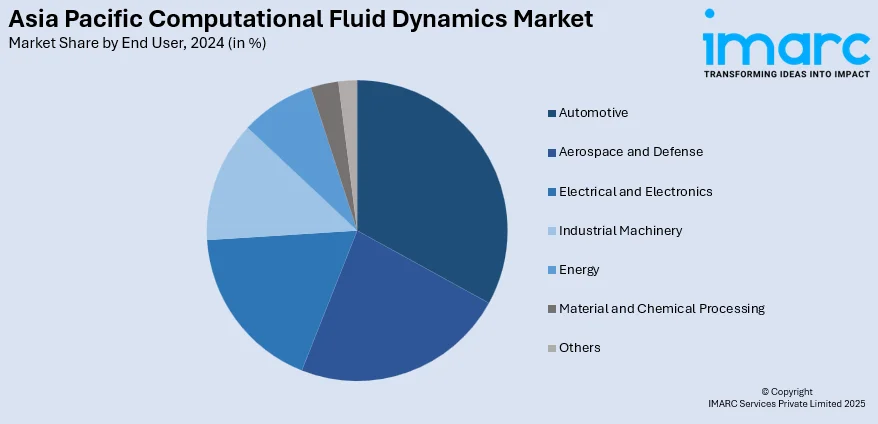
Asia Pacific Computational Fluid Dynamics Market Size, Share, Trends and Forecast by Deployment Model, End User, and Country, 2025-2033
Market Overview:
The Asia Pacific computational fluid dynamics market size reached USD 844.1 Million in 2024. Looking forward, IMARC Group expects the market to reach USD 2,205.6 Million by 2033, exhibiting a growth rate (CAGR) of 10.7% during 2025-2033.
|
Report Attribute
|
Key Statistics
|
|---|---|
|
Base Year
|
2024
|
|
Forecast Years
|
2025-2033
|
|
Historical Years
|
2019-2024
|
|
Market Size in 2024
|
USD 844.1 Million |
|
Market Forecast in 2033
|
USD 2,205.6 Million |
| Market Growth Rate (2025-2033) | 10.7% |
Computational fluid dynamics (CFD) is a scientific method that combines various numerical techniques for analyzing heat transfer, chemical reaction, mass transfer, fluid flow, and pressure distribution of liquids and gases on the object they flow past. It also uses physics, mathematics, and computational software to visualize and design the effects of liquids or gases on interaction with other structures. The CFD process also involves various high-speed computers, solvers, and numerical methods that simulate the flow of fluids while delivering digital prototyping of practical scenarios.

To get more information on this market, Request Sample
The Asia Pacific CFD market is primarily driven by the booming manufacturing industry, particularly in emerging nations such as India and China. Besides this, the rapid implementation of integrated CFD solutions for improved product progress cycles is providing a positive thrust to the market. Furthermore, the rising preference for cloud-based solutions in the defense, electronics, energy, and aerospace sectors has stimulated the market growth. CFD detects errors in different designs before the onset of the manufacturing process, which, in turn, saves costs.
Key Market Segmentation:
IMARC Group provides an analysis of the key trends in each segment of the Asia Pacific computational fluid dynamics market report, along with forecasts at the regional and country levels from 2025-2033. Our report has categorized the market based on deployment model and end user.
Breakup by Deployment Model:
- Cloud-Based Model
- On-Premises Model
Breakup by End User:

- Automotive
- Aerospace and Defense
- Electrical and Electronics
- Industrial Machinery
- Energy
- Material and Chemical Processing
- Others
Breakup by Country:
- China
- Japan
- India
- South Korea
- Australia
- Indonesia
- Others
Competitive Landscape:
The competitive landscape of the industry has also been examined along with the profiles of the key players.
Report Coverage:
| Report Features | Details |
|---|---|
| Base Year of the Analysis | 2024 |
| Historical Period | 2019-2024 |
| Forecast Period | 2025-2033 |
| Units | Million USD |
| Scope of the Report | Exploration of Historical and Forecast Trends, Industry Catalysts and Challenges, Segment-Wise Historical and Predictive Market Assessment:
|
| Deployment Models Covered | Cloud-Based Model, On-Premises Model |
| End Users Covered | Automotive, Aerospace and Defense, Electrical and Electronics, Industrial Machinery, Energy, Material and Chemical Processing, Others |
| Countries Covered | China, Japan, India, South Korea, Australia, Indonesia, Others |
| Customization Scope | 10% Free Customization |
| Post-Sale Analyst Support | 10-12 Weeks |
| Delivery Format | PDF and Excel through Email (We can also provide the editable version of the report in PPT/Word format on special request) |
Key Questions Answered in This Report:
- How has the Asia Pacific computational fluid dynamics market performed so far and how will it perform in the coming years?
- What has been the impact of COVID-19 on the Asia Pacific computational fluid dynamics market?
- What are the key regional markets?
- What is the breakup of the market based on the deployment model?
- What is the breakup of the market based on the end user?
- What are the various stages in the value chain of the industry?
- What are the key driving factors and challenges in the industry?
- What is the structure of the Asia Pacific computational fluid dynamics market and who are the key players?
- What is the degree of competition in the industry?
Need more help?
- Speak to our experienced analysts for insights on the current market scenarios.
- Include additional segments and countries to customize the report as per your requirement.
- Gain an unparalleled competitive advantage in your domain by understanding how to utilize the report and positively impacting your operations and revenue.
- For further assistance, please connect with our analysts.
 Request Customization
Request Customization
 Speak to an Analyst
Speak to an Analyst
 Request Brochure
Request Brochure
 Inquire Before Buying
Inquire Before Buying




.webp)




.webp)












